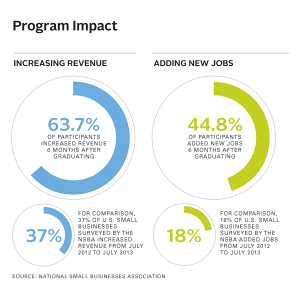How Small Business Owners Can Build Community
Goldman Sachs 10,000 Small Businesses (10KSB) is one of Babson College’s primary economic development programs, focused on helping small business owners grow their business. Since 2010 Babson has been the educational partner for the program, with responsibility for program design, training faculty and business advisors across the country for program delivery, guiding the alumni program, and overseeing measurement and evaluation. More recently Babson became the home site for the blended learning national cohort that expands the reach of 10,000 Small Businesses beyond the eleven educational sites operating in the U.S.
In the last few weeks we released our first progress report for 10KSB. While we’ve shared a few outcome numbers along the way, this was our first release of a systematic look at what we’ve accomplished so far. To date, over 2,000 small business owners have gone through the program. This report summarizes the outcomes for the first nearly 1,300 of those business owners.
One of the things we often remark about in the program is the diversity of people and their businesses. The business owners range from age 26 to 74 while the businesses range from two years old to 102. And yes, those are the family owned businesses figuring out their next generations. The average educational ranges run from a GED to a variety of graduate degrees. And except for services, no industrial sector represents more than ten percent of the businesses.
There are many things of note as far as outcomes and the best way to see the summary of outcomes is on our infographic. The financial outcomes are notable.
At six months after graduation 63.7 percent of those participating have increased their revenues by the six month point after graduation. One point of comparison from the National Small Business Association (NSBA) is that across the US 37 percent of the businesses they surveyed increased revenues between July 2012 and July 2013.
At six months after graduation 44.8 percent of the 10KSB respondents reported creating new jobs. The point of comparison with the NSBA is 18 percent.
The numbers are great. At the same time, it may be the behavioral changes that seem to be a result of the program that will underlie long term economic development. For instance, at that same six month measuring point, 66 percent of the participants report an increase in using financial statements in their decision making. Those of you who lead small businesses know that is a dramatic statement. By this same time point (54%) are also working on improving the quality of their product or service. We see some changes even earlier, just by graduation more than a quarter (26%) is working on domestic expansions. We spend a lot of time in the program practicing how to identify and evaluate opportunities and the benefits of that approach are becoming more and more apparent.
Again, besides the pure outcome numbers, one of our favorite metrics is that by graduation 80 percent of the participants report working together. This is a group of business owners who have worked together to learn to grow, have developed a trusted community based upon peer learning, and who largely share the perspective that the value created in their business should benefit not only them and their families, but also their communities. That’s why it’s my favorite anyway.
Patricia G. Greene
Paul T. Babson Chair in Entrepreneurship; Co-Founder, Diana Project; National Academic Director, Godman Sachs 10,000 Small Businesses

